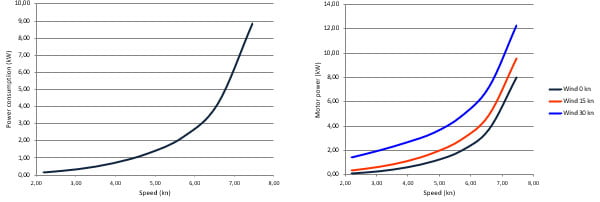Choosing the power of your electric motor is something important. It must be enough to be able to get out of a bad situation in case of heavy seas or a gust of wind, but not too much as it will determine the size of the battery pack and therefore the final cost.
The power necessary to move a boat at a desired speed or to with headwinds depends on many factors :
- Size and shape of the hull(s) and annexes,
- Weight,
- Windage …
- theoretical calculations can give you an estimate of resistance/speed.
Other factors can significantly influence consumption :
- Propeller efficiency: 50/55% if you have a good propeller
- Mechanical losses (friction): 95% if you have good material
- The efficiency of the motor controller: 90/95% for a synchronous motor with permanent magnet and electronic commutation … Much less with asynchronous or brush-excited motors
More information in our article Not all motors are the same Tous les moteurs ne sont pas équivalents ?
In total, less than 50% of the power consumed will be used for propulsion. The loss can be much greater with the wrong choice of propeller, motor or equipment. Savings can sometimes become expensive when you have to increase the size of the battery pack to compensate for low overall efficiency.
Other factors can cause 2 identical boats to have very different performance :
- weight distribution
- the condition of the hull …
So how do you estimate the power required for your boat ?
There are different ways :
- Compare with the power of its existing thermal engine in CV or kW (1 kW = 1.4 CV)
but beware that the comparison is limited because the powers are not calculated in the same way.
A good basis could be to convert 1 KW to 2 HP concerning power, and therefore maximum speed, and 1 kW for 3 HP concerning torque, which allows the boat to move forward in difficult conditions. We explain why in our article How to compare thermal and electrical power? Comment comparer puissance thermique et puissance électrique ? - Ask the boat manufacturer or architect for the boat’s resistance curve in water and against the wind.
It will allow you to determine the power necessary to get out of a bad situation with the sea and the wind and to estimate the boat’s KW consumption in normal weather. You should leave a margin because the curves are theoretical with a boat that is often lightly loaded whose weight is ideally distributed and with a clean hull and propellers. - To help you, we have developed a tool based on a theoretical calculation and on the feedback from sea trials.
By giving us some information, we can provide you with a theoretical power curve in calm seas and with wind depending on the speed. This would of course be only a theoretical calculation that would take into account efficient inboard engines and these calculations must be interpreted in the light of experience, the state of the sea and the boat. The tool would show you how additional nodes are sometimes very expensive in terms of consumption.
Example of a power calculation

This tool could help you make a decision, but it is in no way a recommendation. Our experience shows that the loaded weight is often underestimated, we recommend you to leave a margin.
@
Send a request to estimate the power needed
to motorize your boat
How to assess autonomy ?
A 1 kW motor will consume 1 kWh at full power over a period of 1 hour. We will double or triple the range by reducing the speed very little.
It is good practice to start with a ratio of 1 between kW (engine power) and kWh (battery pack capacity), even if it means leaving room for future expansion. Please note that this rule applies with LIFEPO batteries. Other chemicals require a larger pack. As for AGMs, it will be necessary to foresee that they should not be discharged more than 50%.
It is possible for a small boat to bring a small portable generator of 1 or 2 KW as a precaution. Connected to the charger, it will allow you to return to port at low speed even if the batteries are empty.

